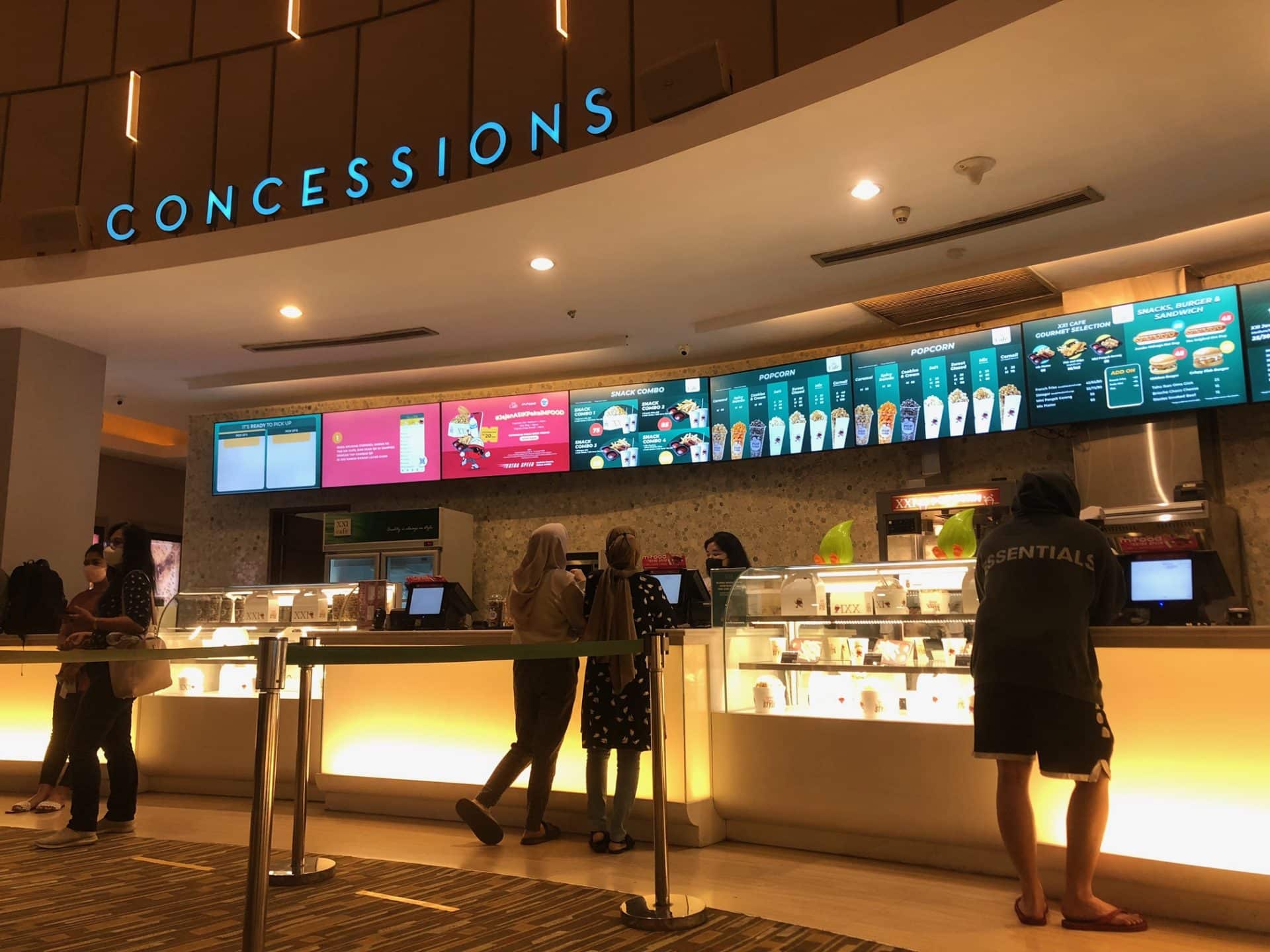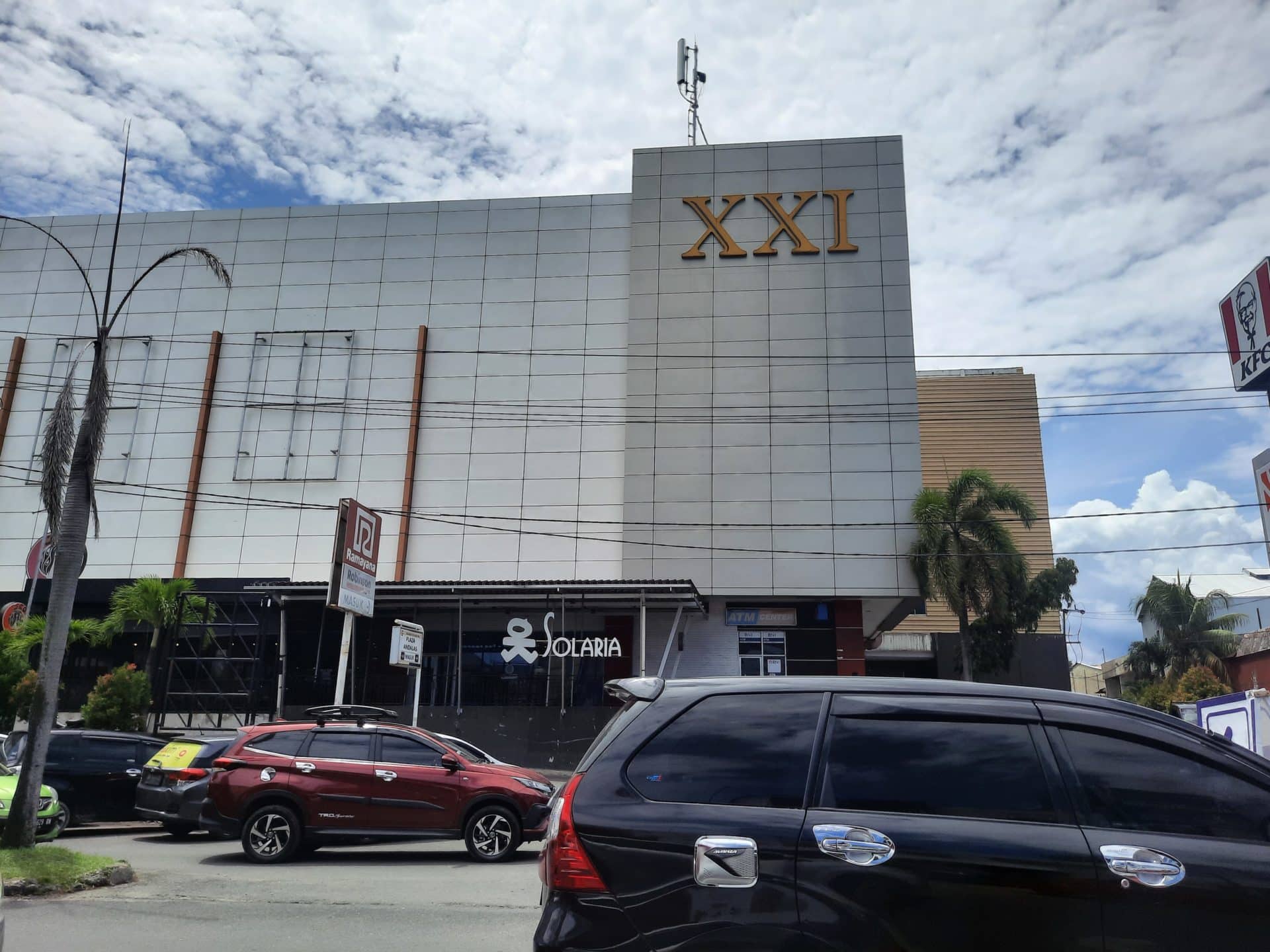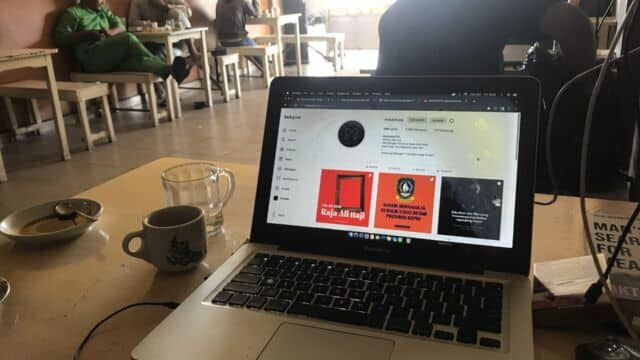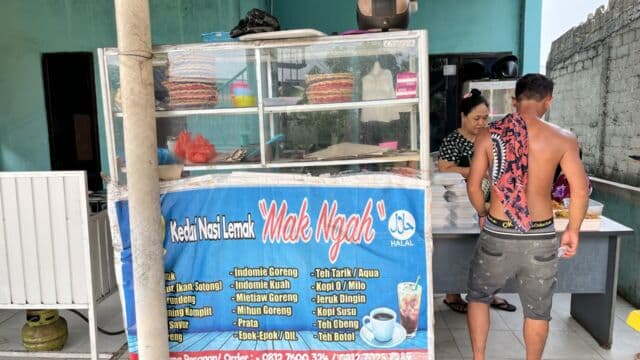Silver Screens of Sumatra
Photo: Shinta Pristianti
A cinema in Padang | 1,500 words | Translated from Bahasa Indonesia by Lise Isles
‘Sure, sister – one packet of pop-kron, plus a drink. That’ll be twenty thousand, sister.’
The girl was smiling at my husband and I who had just settled our rumps down onto the plush blue chairs. She looked young – in her twenties, likely. She was wearing dark black pants, and a red shirt with a splash of gold – the latter combination of colours was matched on her cap. Indicating what her hustle was, a box full of food and drink hung in front of her chest from straps on her shoulders.
I met her smile, then looked sheepishly at the ground. For my grin was not just a way to politely say no to the snacks being hawked, but also amusement at her way of hawking them.
Yes, I know – she was offering that iconic food for watching films in the cinema, popcorn. Yet this girl was saying ‘pop-kron’. At first I thought I’d misheard. But when she moved on I heard it again, the two syllables repeated at every opportunity, like a recitation. ‘Pop-kron. Pop-kron. Pop-kron.’
*
My husband and I are migrants, having moved from the bright lights of the Indonesian capital Jakarta to a small tourist town in the seemingly different world of West Sumatra. Being born and raised in Jakarta made us accustomed to a modern lifestyle and to having every possible convenience. This included watching films in the cinema, a shared hobby.
In Jakarta we’d go to the mall at least once a week to watch movies. For much-anticipated films, my husband and I usually adjusted our schedules to attend the premiere. So much did we enjoy watching films at the cinema that sometimes we engaged in movie marathons, buying a bunch of tickets after appraising screening times, film durations, and how much of a break we’d have before the next movie we wanted to see. Usually we’d watch three films back-to-back, taking up a whole day. The cinema you could say is a vital need for us.
It turned out that Bukittinggi, the city we moved to, had no modern cinema. So when a major Indonesian cinema chain opened a new theatre in Padang, a bigger city down on the coast – well, it was an enormous deal to us, and we weren’t going to miss the opportunity to visit and watch a film, or two.
Even though the distance from Bukittinggi to Padang is around 90 kilometres and along bad roads, so much so that the trip usually takes three or four hours, it wasn’t a hindrance to us. Although I’ve travelled the road countless times, it still can make me carsick. Understand that freeways and toll roads of the type you find in big cities, without obstructions and featuring lots of lanes, are yet to arrive in this part of the world. To get to Padang involves travelling on a road that curves and winds endlessly, going through mountains, then over a bridge spanning a river full of large boulders. The views are stunning though, especially when going past the Lembah Anai waterfall beside the road.
No wonder people had come in droves. The interior was glittering.
But it was still possible for us to return to Bukittinggi on the same day. Before this Padang cinema opened, my husband and I were driving around six hours to get to Pekanbaru, then the closest city to Bukittinggi with a modern cinema. Like it or not we had to stay a night or two there for the sake of satisfying our desires to go to the movies.
The Padang cinema had been built on level four – the top-most level – of the Plaza Andalas mall. Weeks after it opened, it was teeming with people.
Young boys and girls were sitting along the hallways, their backs against the walls and their feet stretched out in front of them; little kids were racing about; teenagers were babbling away excitedly; and children in school-uniforms were busy taking selfies here, there and everywhere. But the unrivalled champions were a group of Sirs and Madams from the public service who were having a photo-shoot in front of the entrance, giving every sign of indifference to the difficulties that their presence was causing to everyone trying to enter or exit the cinema.
Two security guards at the entrance looked imposing in their black uniforms, but in the case of the public servants they only looked on. I assume they were reluctant to reprimand them, given how powerful and high-status public servants are in Indonesia – though perhaps it was more because their workload was high due to how crowded the cinema was.
But they did find time to greet everyone who entered the cinema with a ‘good afternoon, welcome’ and a smile – friendly greetings being another, possibly contradictory part of their job. This included my husband and I, as we pushed open the glass doors and went inside.
I smiled to myself. Who’d have thought, after years of waiting for a modern cinema in West Sumatra, it had finally happened. My eyes quickly began following the goings-on in the lobby.
No wonder people had come in droves. The interior was glittering. Posters of films, solidly-framed, covered almost all the walls, and were being used as selfie backgrounds by visitors. Yellow lights hung everywhere, inevitably adding to the space’s splendour.

There were six theatres. This cinema was actually far bigger, and more comfortable, than the cinemas in Jakarta malls that I’d so often visited. The atmosphere was truly potent enough to salve my longing for the hedonism of Jakarta.
A queue for the ticket counter was snaking back and curling around on itself. The pretty girls employed as attendants – in black dresses and with their hair tied in buns – were spiritedly serving customers while being laudably patient with their behaviour. Some patrons were confused about choosing seats, some groups of friends were insisting on paying separately, and there were even people who still didn’t know what they wanted to see even though they’d already arrived at the counter.
I glanced at my left wrist to see the time. No need to rush yet for the film we wanted to see. My eyes returned to what was happening here in the cinema lobby.
Next to the ticket counter was the counter for food and drink. Enough to awaken your senses. A mountain of popcorn was exposed in all its splendour behind glass. It wasn’t merely a feast for the eyes with its rich yellow colour, but also emitted an aroma of butter that was too tempting.
I couldn’t believe it had taken this long for a modern cinema chain to come to the capital of West Sumatra Province. Before this, my desire to watch films had taken me to a Padang cinema in the district of Pasar Raya. Occupying its own building rather than being inside a mall, and having a large parking lot, meant the cinema actually had more potential to be visited by more patrons. But it was visibly not taken care of, and I was nervous throughout because several times mice crawled over my legs. Ick.
Such rodent-collision-experiences made me appreciate even more watching films in modern cinemas. And finally that opportunity had come to West Sumatra.
When the film finished I went to the toilet: several other female patrons did the same thing. I mentally prepared myself to be patient if conditions inside were less than clean and less than orderly – i.e., for there to be cutting in line. My time in the land of Sumatra has made me aware that there’s a definite anti-queue culture among some people here.
But my apprehension did not come to pass. Entering the toilet, I was surprised. Women of all ages were lined up waiting their turn. Orderly. Neatly. No cutting in – people’s position was in perfect accordance with their arrival time. Huh? How come?
In front of the queue stood an attendant. She was not only efficiently cleaning the stalls after visitors had used them, but also supervising the line of mothers, young women, and little kids holding in their pees. This attendant was deciding which stall each customer could use and was not shy about firmly reprimanding if someone tried to skip ahead. ‘Madam: please join the queue Madam…’
Again, I smiled to myself. The arrival of a modern cinema, it turns out, can simultaneously be an educational tool for the citizens of a city: to teach discipline in queuing and discipline about being on-time. Because yes, the films here begin on-time. If you’re late even five minutes, gone is your opportunity to watch the first scene which so often holds the key to understanding the next ones.

‘Let’s go home’, my husband said after I had emerged from the toilet. We walked hand-in-hand toward the exit, leaving behind the fragrance of the ‘pop-kron’ as it erupted and exploded in its case, leaving behind the beautiful faces of the counter staff as they restrained themselves while a couple in front of them debated what film to see, and leaving behind a different group of government officials having fun taking selfies. The smiles did not leave our faces.
© Dessy Liestiyani
English translation © Lise Isles






